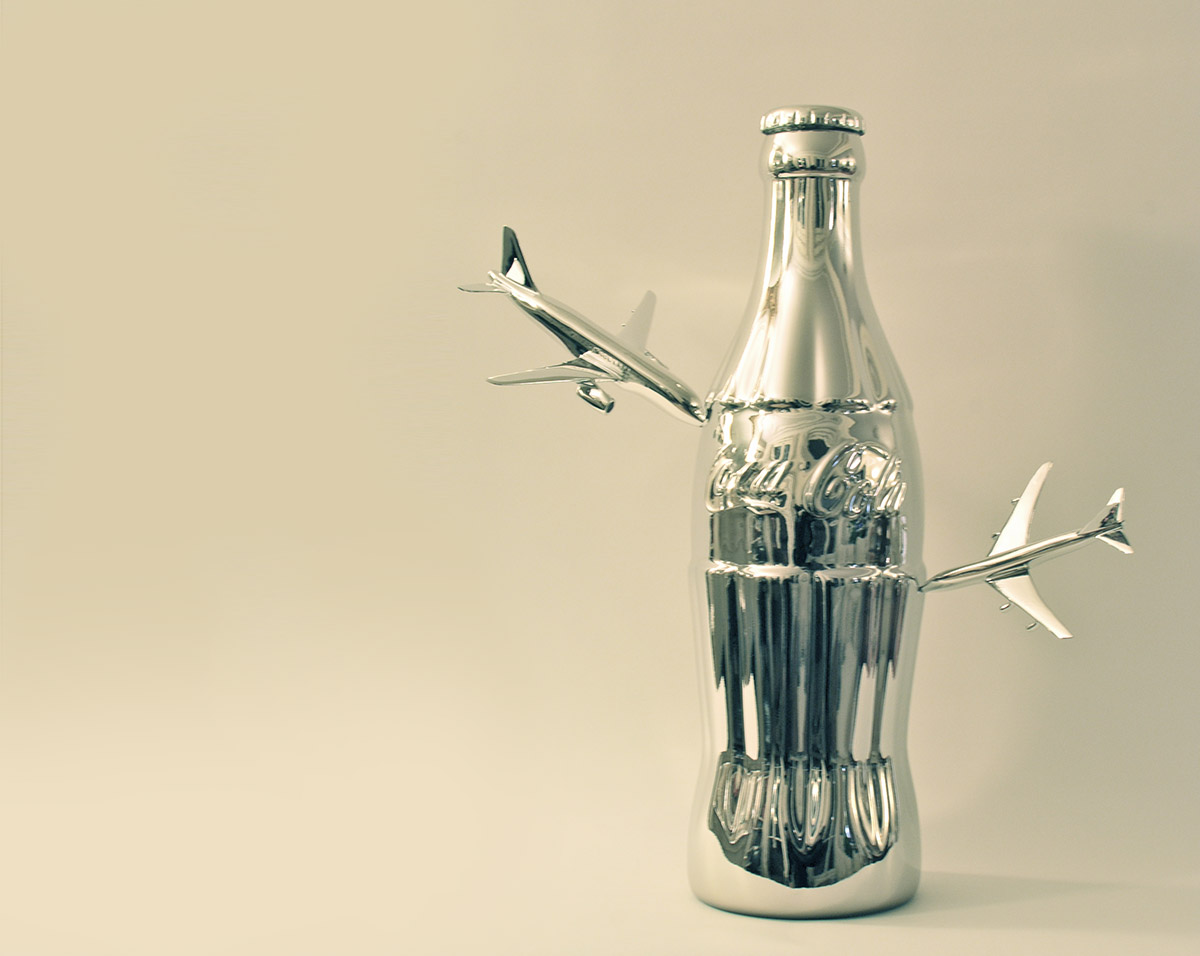G.WEN: Arnaud Cohen Who are you? Your life and artistic path ?
Arnaud Cohen: I am a French artist, and recently also Portuguese, 54 years old. I grew up in Antony, a suburb of Paris, in a family of doctors. Collectors and friends of many contemporary artists of their generation (I grew up among them), my parents were also keen on antiquity and classical culture. My mother studied medicine but also went to the curatorial school of the Louvre Museum where she took me as a child every Wednesday. Although I did not go to the Beaux Arts in Paris, I believe that I am in fact as little self-taught as one can be.
My first exhibition was in 1997, at Art Brussels with the Marwan Hoss Gallery. I exhibited one of my collages which dealt with the war in Bosnia, in particular the Sarajevo siege, and the relative indifference/impotence of the European populations. We are in 2022 and I am writing these lines while the siege of many Ukrainian cities has begun. It is frightening how history stutters.
The hazards and necessities of life meant that, in parallel to my artistic career, I had to do a whole bunch of jobs until 2002, some despised, like door to door, and others highly regarded, like director in the strategy department of one of the biggest American consulting firms.
In 2003, I left Paris and moved to an abandoned industrial wasteland on a river island south of the Loire Valley. I have made the island my studio and home for the past 20 years. We sometimes organize memorable parties there.
Although I am not abandoning this unusual place, I have now decided to live and work part of the year on another island, Mallorca, Spain.
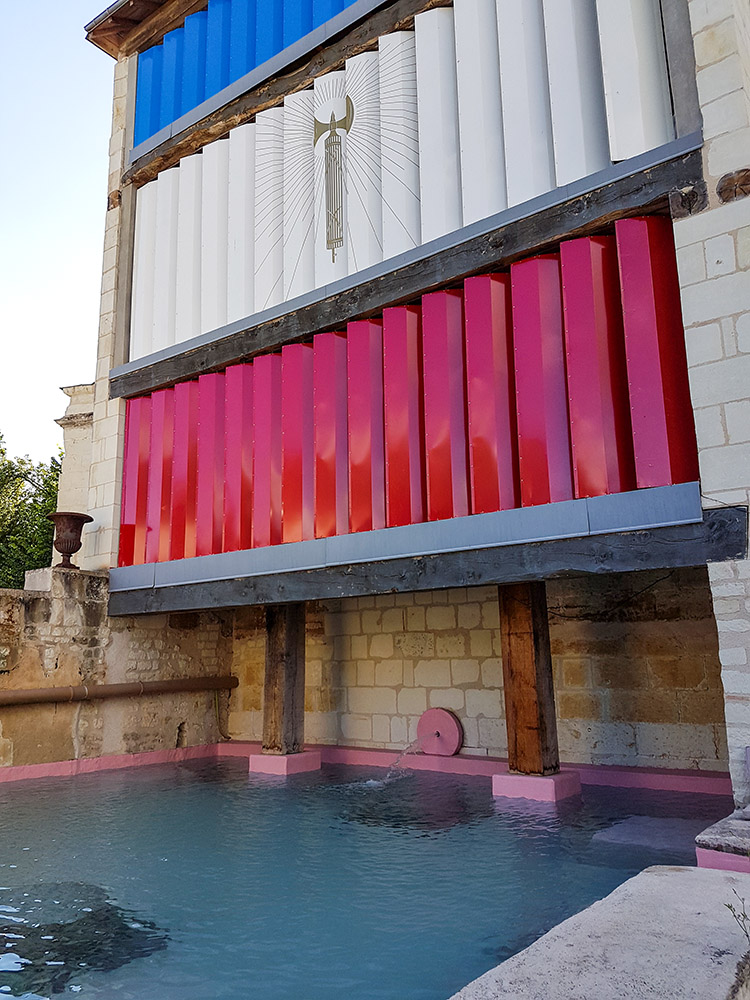
Parcours – Studio Exterieur – JE SAIS QUI VOUS ETES 2016
In the future, I would like to connect these two islands, and others, to populate them with friends, researchers and experimenters like myself, in the manner of an anti-gulag archipelago, a creolized network as Glissant could imagine them. Through Spain, I also reconnect with part of my roots. Indeed, my paternal grandparents were Spanish-speaking Jews from Istanbul. Their family had to leave Spain and Portugal 5 centuries ago because of the Inquisition, but they never gave up their language.
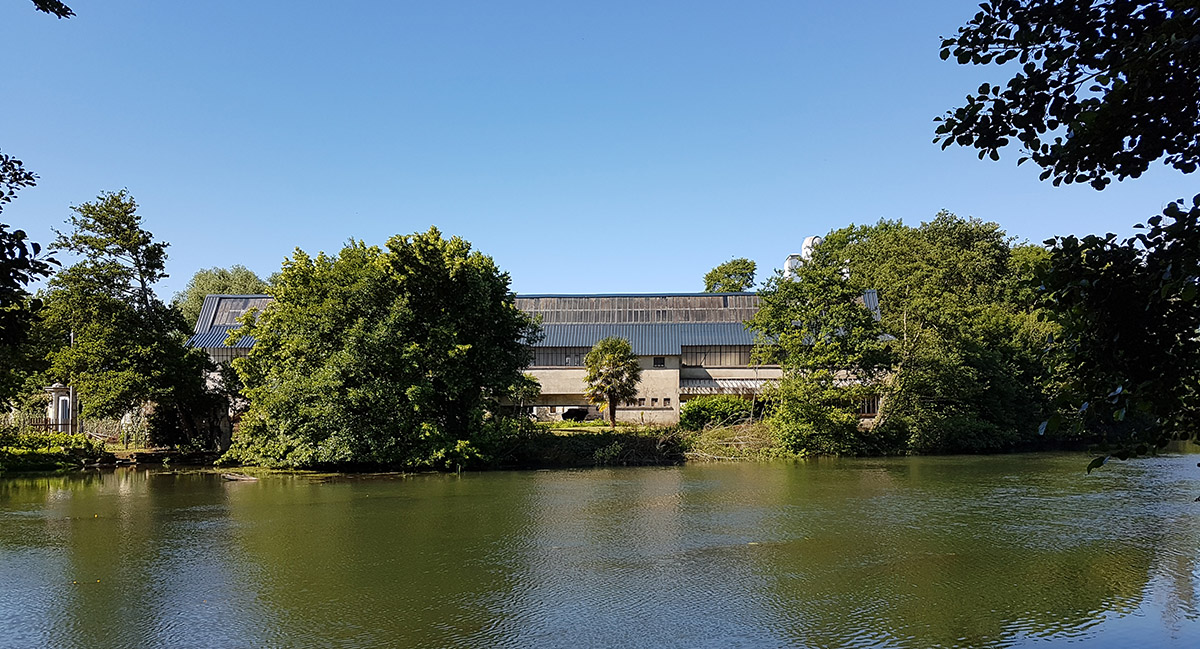
Parcours – Studio
G.WEN: Tell me about your problematic?
A.C.: The short biographical text that introduces a recent presentation of my work says of me that “through my work I approach my two favorite subjects: that of individual responsibility in the construction of collective destinies and that of a memory in permanent recomposition. Drawing my formal inspiration from architecture and in particular from the practices of reuse in architecture, I refer to the situationists and Édouard Glissant as much as to allegories and mythology. My appropriationist practice leads me to social and aesthetic forms as diverse as a foundation, a dance floor, or an assemblage of historical remains.” The truth is simpler. I’m pretty well equipped to understand this world, both in micro, psyche-level terms, and in macro, geopolitical terms (I loved this subject when I was a student and I still spend an hour a day on it every morning before I start my day). Making art out of this dual sensibility is what seemed most relevant to me. It’s almost as complicated as trying to unify quantum physics and relativity theory, but that’s good because I just can’t stand boredom.
G.WEN: What are your artistic influences?
A.C.: They are innumerable. If I had to choose a family, it would be that of the Belgian moderns and contemporaries, from Delvaux to Delvoye, via the immense Broodthaers. I am therefore extremely flattered that my work will join theirs this year in the Belgian public collections of BPS22.
I also liked the Swiss Dadaists very much, and some giants like Brauner, Bellmer, Beuys, Tapies, Rauschenberg, Paik or General Idea.
I am not very sensitive to plastic photography, even though I have done some myself, with the notable exception of Koons’ Made in Heaven series. To me, this is his only really major artistic production, a new Déjeuner sur l’herbe.
Although it is not my subject, I also admire some painters, especially if they deal with architecture. Delvaux again, De Chirico, Dali, and last but not least, Bacon. It is the architecture that is really the elephant in the room in my work. Among my contemporaries, I like Perry a lot, whom I discovered late in life. But I must say that few artists impress me as much as Altmejd since his 2015 exhibition at the Musée d’Art Moderne de la Ville de Paris. And in the younger generation I am literally blown away by Loze. If there is to be one genius per generation, then it must be her, provided of course that she manages to do in English what she excels at in French.
G.Wen: Tell me about your first piece Campaigns JPR?
A.C.: JPR Campaign is far from being my first piece, but it is indeed the first piece after a 5 year break in my artistic practice, a break linked to the closing of the Marwan Hoss Gallery and the loss of my Parisian studio. Having to rebuild myself financially, I finally decided to work for two years as a director in the strategy consulting department of Arthur Andersen. With this experience and the financial independence it gave me, I decided in 2005 to launch an artistic action under the pseudonym of Jean-Paul Raynaud (JPR). This name reminds me of Jean-Pierre Raynaud. Indeed this one was then in France the archetype of the artist whose fictitiously committed posture was a pure product of the French ecosystem of the time. For me, it was a question of using the tools of consulting (matrices, slide shows…) and associating them with the tools of marketing and political propaganda to realize an artistic intervention in the Parisian public space. If this one had all the appearance of a political campaign, the operation aimed in reality, by a work of deconstruction, to expose the mechanisms of compromise of the French artists who, to succeed in what was then a pyramidal state system completely cut off from what existed everywhere else in the Western world, had to give up any creative audacity and any critical discourse.
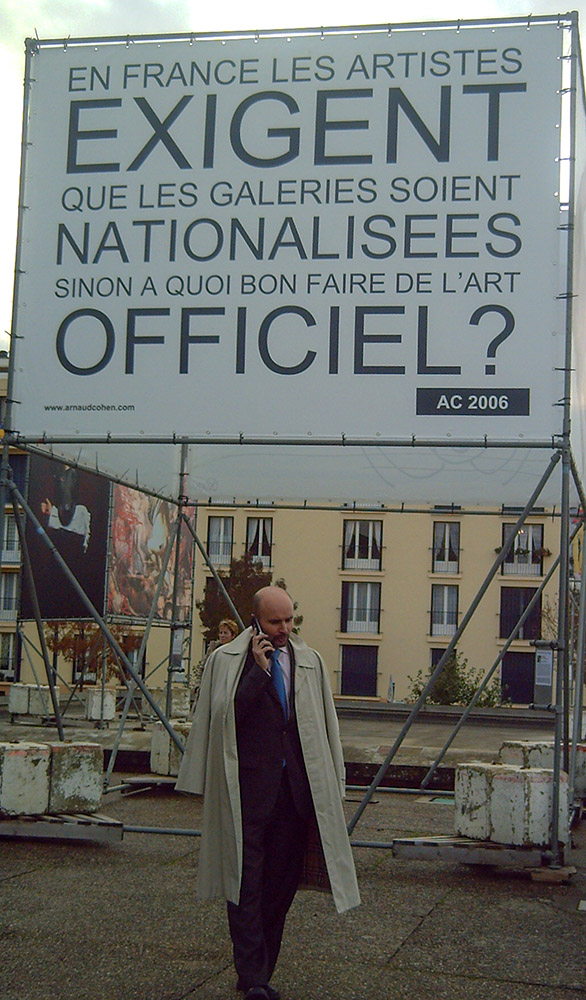
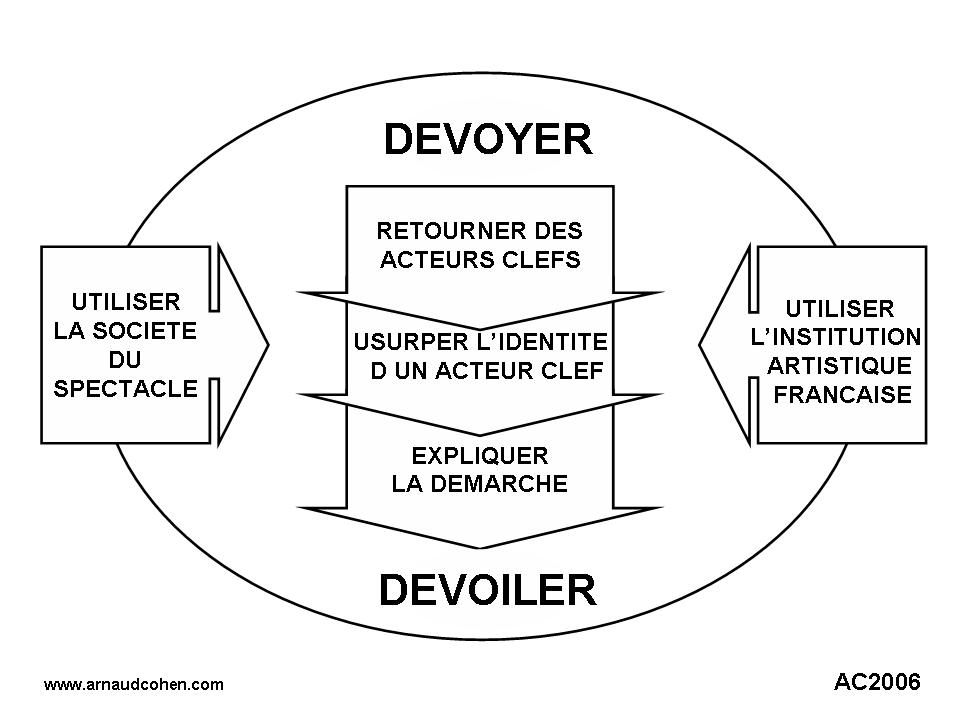
CAMPAGNE JPR – AFFICHE N2 6 2006
G.Wen: Tell me about your play The Kiss?
A.C.: The Kiss takes its title from a sculpture by Brâncusi. It is the assembly in polished and chromed bronze (or red) of an enlarged Coca-Cola bottle hit by two reduced airliners.
Each of these elements which telescope is in itself iconic of a period which opens in 1945 and closes a certain September 11: The bottle incarnates the pop art, the American way of life and the mass consumption which it glorified, the planes are one of the two great vectors of the globalization of the exchanges and the mass tourism. In the immediate post-World War II period, airplanes and bottles together embodied the air bridge linking the free world to Berlin under siege. 50 years later, the explosive combination I propose covers the rejection of American hegemony by fanatical Islamists with a sense of identity, the reversal of economic and cultural tools of domination against their masters, and the collapse of the consumerist model, amplified by the problem of the wars to come over water resources. It takes up to nine liters of water to produce one liter of Coca-Cola. This sculpture also allows me to metaphorically stab the one who dominates the world’s sculpture at the time, Jeff Koons, and his enlarged and smooth objects that desperately lack something to make them more than just rattles for the world’s oligarchs.
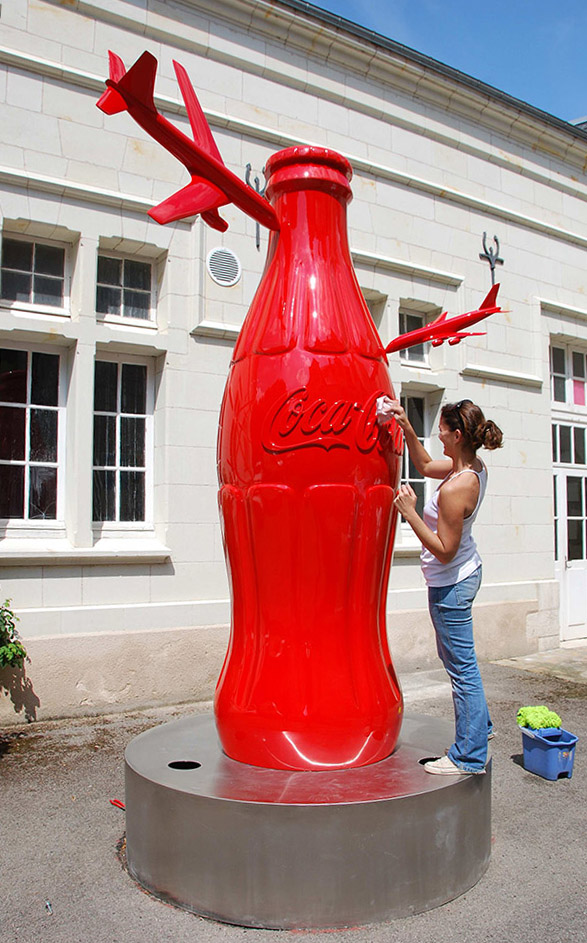
Big Red Kiss – 2009
The assemblage I propose in 2007 is so obvious that it seemed certain that it must have been imagined and conceived by someone else as early as late 2001. But, to my great astonishment, it was nothing of the sort and the obviousness, as is often the case, only becomes clear when you come into contact with it. “To create a poncifix, that is genius” wrote Baudelaire. I had this rare chance with this piece.
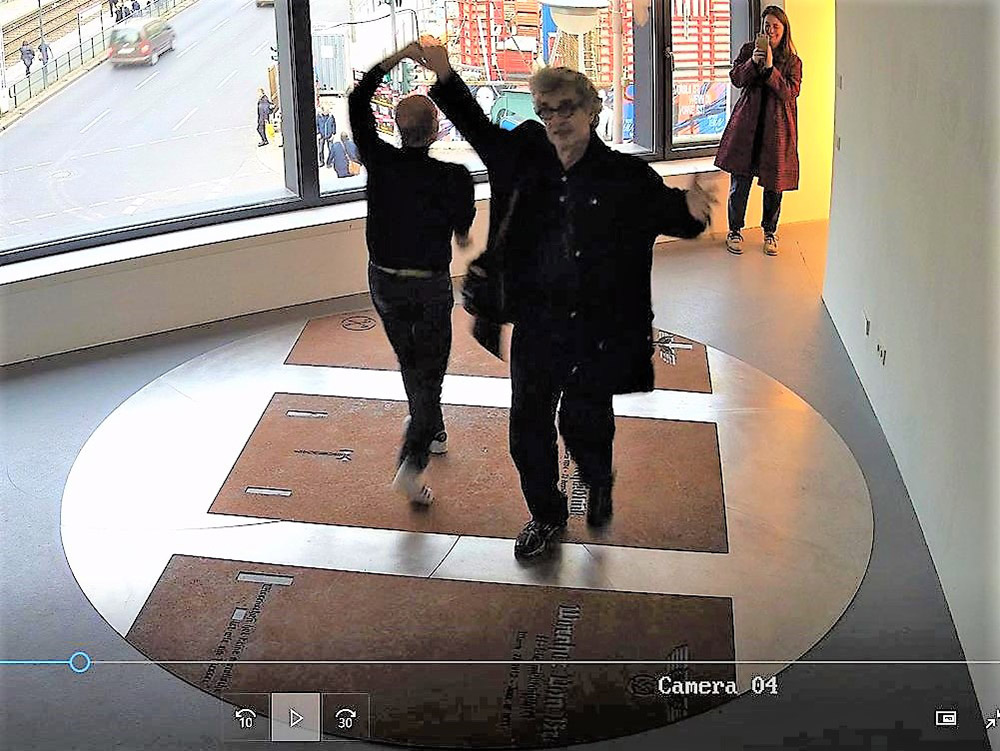
Dansez sur moi – snapshot from video with Wim Wenders – 2018
G.Wen: Tell me about your piece “Dansez sur moi”?
A.C.: “Dance over me” draws its inspiration from my French factory island past. When I bought what had become an industrial wasteland left to ivy, brambles and looting, I knew nothing of the place’s past. It was only with a lot of patience that I came to know what everyone had preferred to forget: from 1940 to 1944, V1 parts were manufactured there for the Nazis. The work, in its various Franco-German, Argentinean, Ugandan, Guadeloupean, Romanian editions, completed or in progress, is an experimental and empirical attempt to
– produce a trace, even fictional, of a very real but disappeared past,
– to approach one of the main engines of the past victories of the totalitarianisms on the democracies: the collaboration of the economic, political and cultural elites,
– to propose a third way between, on the one hand, the creation of works tending to be commemorative monuments, and on the other, the pure and simple negation of the past.
Everywhere on the planet, by dancing on the representations of the graves of the executioners, the families of the victims can overcome their fear and not let the memory of the bastards be forgotten. In Berlin at the Kunstverein at Rosa Luxemburg Platz in 2017, in Paris at the Mémorial de la Shoah in 2018 (DJing by you my dear G. Wen) and at the Confort Moderne in Poitiers in 2019 (DJing by Vidal Benjamin and Jeff Lasson, curator Yann Chevallier), one could dance on the graves of Nazis; in Buenos Aires and in Paris in 2019 on the graves of the executioners of the Videla dictatorship (curators Anibal Jozami, Diana Wechsler and Romain Tichit). Anonymous visitors or celebrities (like Wim Wenders in Berlin), all felt the cathartic power of the experience. The Hikvision video surveillance cameras (the brand used by the People’s Republic of China to monitor its population) are here intentionally perverted in their use: they are there to capture evidence that life is possible in the presence of this strange tool at the service of memory. Thanks to the support of international curators such as Enrico Lunghi (former director of MUDAM Luxembourg), the victims of the Romanian dictatorship will hopefully be able to dance on the graves of their executioners at the MNAC in Bucharest in the fall of 2022.
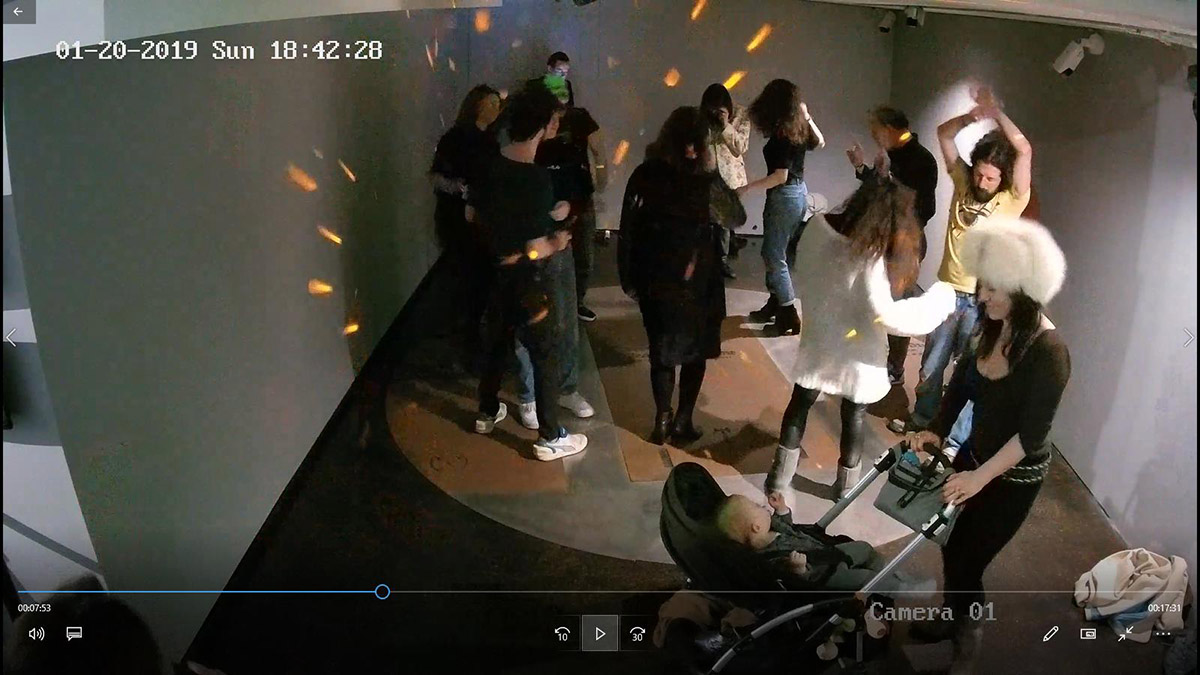
Dansez sur moi – Memorial de la Shoah -2019
G.Wen: Tell me about your piece “Art Speaks For Itself”? How did you reinvent culture?
A.C.: ASFI is a fictional foundation aimed at highlighting the main causes of the standardization of contemporary art on a global scale. This work actually allowed me to be honored in 2015 by the Figaro as one of the “10 personalities who reinvent culture”. Thanks to Valérie Duponchelle for these 15 minutes of French fame.
Although without legal existence, ASFI leads a network of international curatorial residencies. In September 2014, I inaugurated my first residency in Paris, which was none other than my own apartment, and the following year the second one in Milan with the complicity of Adama Sanneh from the Moleskine foundation. This work of art is for me a utopia that does not give up to be embodied. I have surrounded myself in this enterprise with French and foreign personalities such as Anne Barlow, Simon Njami, Florence Derieux, Georges Didi-Hubermann, Rebecca Lamarche-Vadel, Enrico Lunghi, Jean-Hubert Martin, Sandra Hegedüs, Damien Brachet and Marie-Ann Yemsi. The first guest was Wang Chunchen, curator responsible for the first Chinese pavilion at the Venice Biennale. ASFI‘s curatorial protocol was applied in 2018 to the feminist exhibition at Tate St Ives dedicated to the writings of Virginia Woolf and curated by Laura Smith (since curated at the Whitechapel Gallery in London), and in 2015 to one of the exhibitions at MUNTREF, the Museum of Contemporary Art in Buenos Aires.
I have also been invited to perform this work in many biennials:
2017 Venice Biennale, curated by Koyo Kouho (Swiss Pavilion, Pro Helvetia )
2017 Biennale of South America BIENALSUR, curators Anibal Jozami and Diana Wechsler
2016 Dakar Biennial, curator Simon Njami
2015 Something Else Cairo, curator Moataz Nasr
ASFI has also benefited from public presentations at the Centre Pompidou at the invitation of Alicia Knock as part of Museum On/Of, at the Untref Museum in Buenos Aires as well as at the Château de Montsoreau – Musée d’Art Conceptuel as part of Protest.
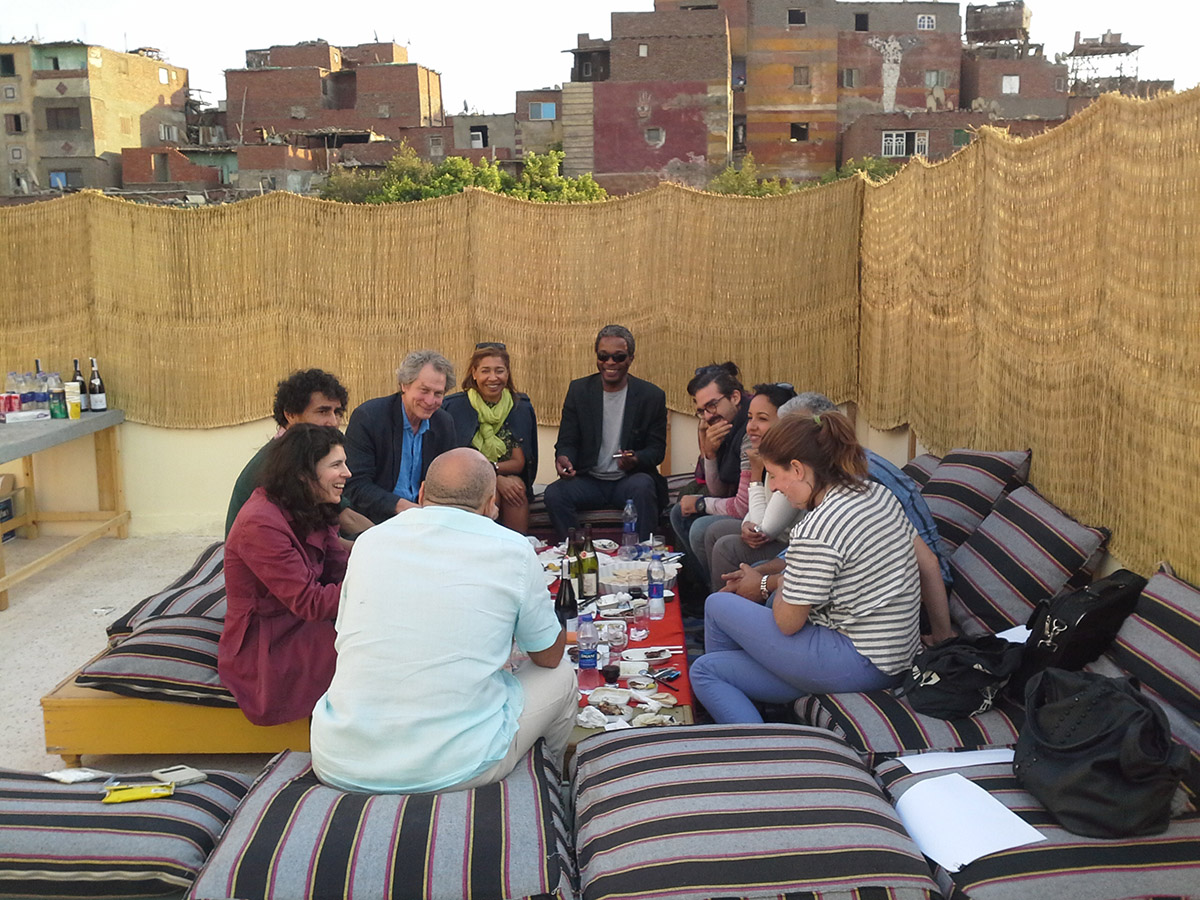
ASFI lunch performance at Cairo Something Else Biennale – 2015
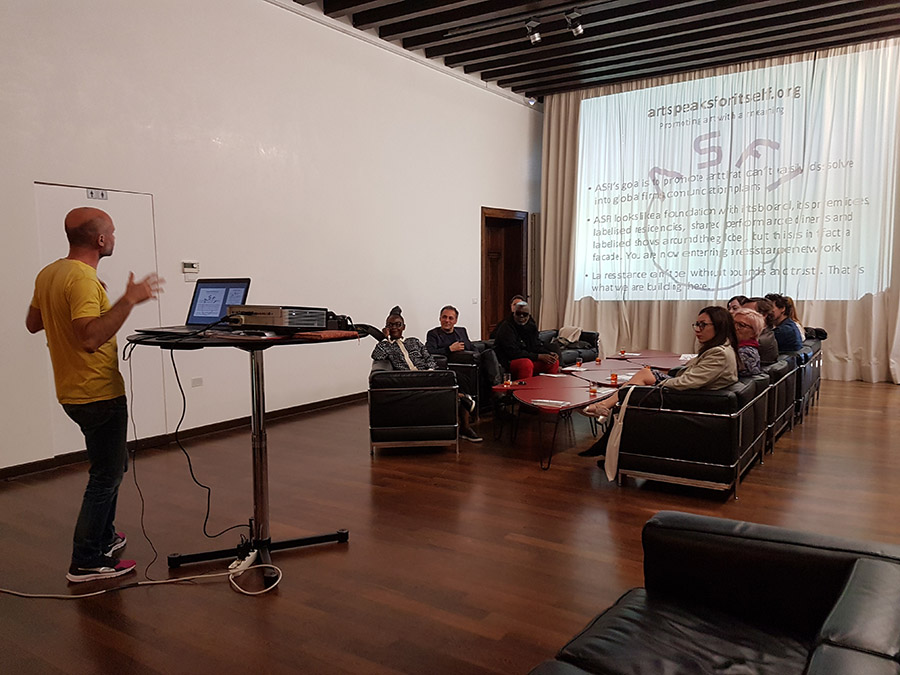
ASFI performance – Venice Biennale 2007, official swiss program, curator Koyo Kouoh
G.Wen: What are your current artistic projects?
A.C.: With Art Speaks For Itself, I wanted to conceptually arm myself and my curatorial friends against the major changes brought about by the new sponsors of the contemporary art market, which have become the foundations of large global corporations. It seemed important to me to point out a path where frugality and marginality paradoxically allow more room for maneuver than the centrality and credit lines offered by these foundations. These are all short leashes for curators forced into implacable submission. I have decided to go further by opening soon a place that is both experimental and geographically marginal. It will be Babel Mallorca, in connection with Babel sur le Clain, my French island-factory. Opening planned for 2023.
G.Wen: Can you tell me about your current projects?
A.C.: In April I will have an exhibition at the Musée de la Cavalerie in Saumur, France, and a solo show that I would call experimental (in the sense of ASFI’s philosophy) at the Galerie Valérie Delaunay in Paris; in May an exhibition in Isère, France with my friend Paul Ardenne; in September and October an exhibition at the Palace of the Dukes of Bragança in Portugal, and from September to March an exhibition at the Bargoin Museum in Clermont-Ferrand, France with my friends Christine Athenor and Thomas Leveugle. In November 2022, if the war does not postpone again what the covid has already postponed by two years, I will have a solo show at the National Museum of Contemporary Art in Bucharest, Romania with my friend Enrico Lunghi.
If I speak of friends in every line of my news it is because for some years I have decided to work only with courageous and generous people. In these particularly troubled times, one can only enter the resistance in good company. My criteria may seem very restrictive, but good people are more numerous than one might think, so I don’t have to look for more embarrassing company.
G.Wen : Your art influences the society ? and how ?
A.C.: Art does not influence society, but it sometimes tries to make it aware of what inhabits it and drives it unconsciously. To participate by my work to this awareness, to this unveiling of reality, is nevertheless to try to influence our collective destiny for the better. All this may seem contradictory, but not so much. All Cassandras are not necessarily condemned to be neither heard nor believed. That’s why I haven’t given up creating yet, despite a feeling of guilt linked to the already too large number of useless objects produced every second by the countless artists, craftsmen, machines and robots that populate this planet in the process of exhaustion.
G.wen: What is your artistic playlist?
A.C.: If you mean the music I listen to when I work in the studio, it’s mostly 2000’s electro, it keeps me on edge all day. If you want to talk about the musical artist that inspires me the most, it’s David Bowie. His constant renewal that stretches over half a century is linked to an extraordinary quality of plundering, reusing, shifting and assembling.
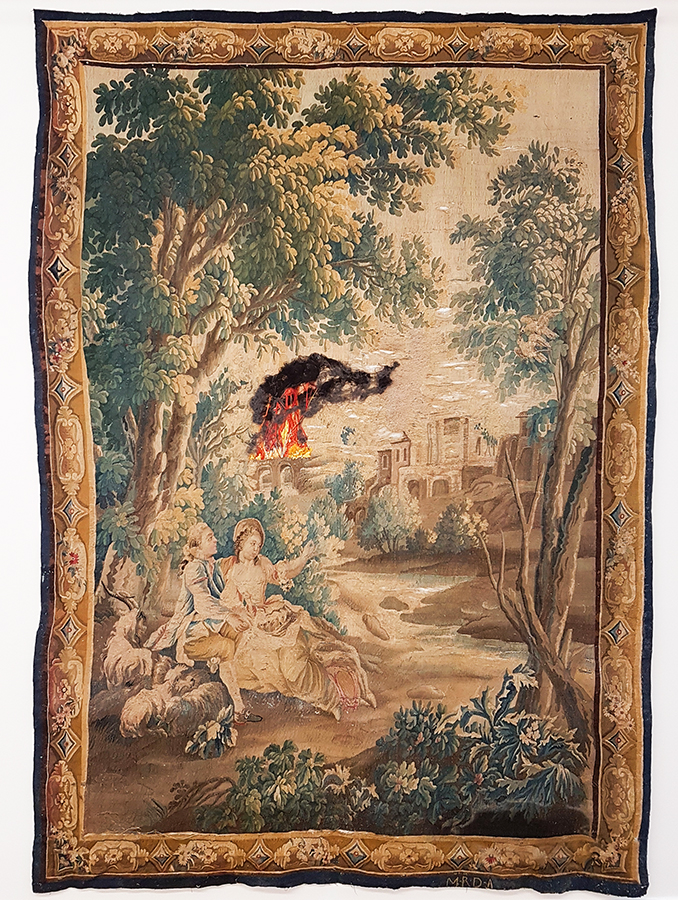
Influence – Winter over Europe the Aubusson Tapestry 2018
He himself was largely inspired by the cut up practices of the beat generation. If I had to choose a Frenchman it would be Alain Bashung. Superbly brilliant on much shorter periods of creativity I also have a lot of respect for bands like the Stranglers, Public Image, the Psychedelic Furs, the Prodigy or the Rita Mitsouko.
G.Wen: What is the medium of choice for your work? Is your artistic approach in phase with society?
A.C.: It doesn’t matter the medium as long as it is reuse. Since the very beginning my work has arisen from the confrontation of objects or traces of existing objects; a theater leaflet, a tart card, a piece of Egyptian antiquity, fragments of Youtube videos of neo-fascist groupuscules, a three hundred year old tapestry in a sorry state, a Japanese mask from the Edo period, plastic toys from McDonald’s. To paraphrase a famous maxim from Ridley Scott‘s Blade Runner, if I don’t do something about it, “all these objects will be lost in time like tears in the rain.” This approach, which began 30 years ago, had a double dimension at the time, that of a memory in peril and in permanent recomposition, and that of a commitment to question the present and the future with tools forged today in the material of the past. Reuse finds today in our societies the dimension which was his until the first industrial revolution, that of the circular economy, that of the economy of means: at a time everyone understands well that the best energy is the one which is not consumed, my practice is particularly in phase with what the society should not delay to become if it wants to survive this terrifying century in which we entered full foot.
G.wen: How does your piece Dance on me echo the dramatic news in Ukraine? The Russian invasion must resonate with you in a disturbing way?
A.C.: Dancing on me sheds light on Hitler’s collaborationist elites, those bastards who worked not FOR him, but WITH him to satisfy their personal ambitions. Hitler would not have been able to carry out his disastrous project without their help, as precious as it was self-serving. Dictatorships will continue to flourish as long as the crimes of the elites continue to be judiciously rewarded. I am therefore very happy to see that the world seems to have finally learned its lesson by having, as a first retaliatory measure to the invasion of Ukraine, decided to seize, everywhere on the planet, the assets of Russian oligarchs. This will certainly not prevent the martyrdom of the Ukrainian people, but, who knows, it could perhaps make the Chinese oligarchs think about it, one can always dream…

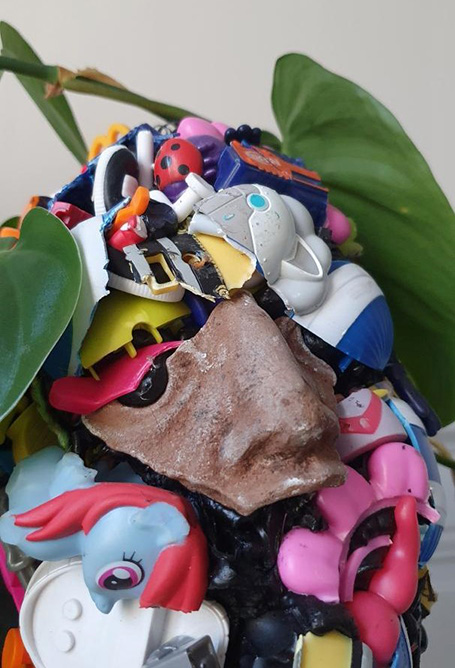
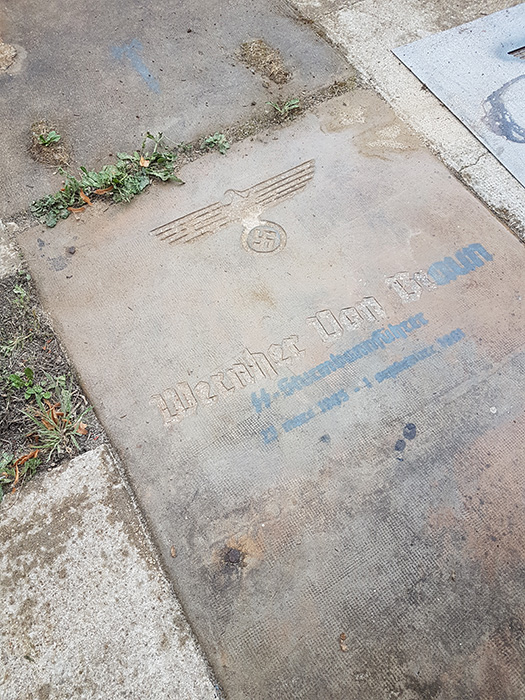
Influence – Winter over Europe the Aubusson Tapestry 2018
Medium exhibit 2, detail – 2022

